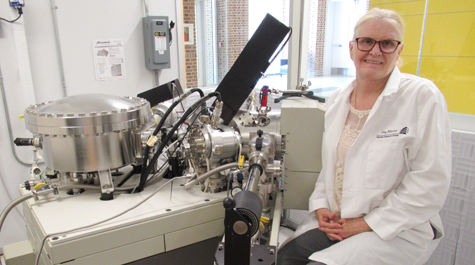Core labs of William & Mary are relocated and open for science & engineering
The core labs of the Applied Research Center are open for science and engineering after relocation to the science buildings at William & Mary.
Amy Wilkerson, the laboratory and research manager of the core labs, supervised the move of the assets of the university’s Applied Research Center from its long-time home adjacent to Jefferson Lab in Newport News.
“We used to have nine laboratories in that location. Probably half of them were devoted to core instrumentation of one sort or another,” said Dennis Manos, William & Mary’s vice provost for research. “All of that instrumentation has come here.”
Core laboratories are equipped with instruments that are commonly used by many researchers across many disciplines. William & Mary’s core labs are themselves part of a “core of core” laboratories across Virginia, connected by a five-year memorandum of understanding among Virginia Commonwealth University, George Mason University, the University of Virginia, Eastern Virginia Medical School, Old Dominion University and Virginia Tech — as well as William & Mary.
Both Manos and Wilkerson say they’re not surprised by the increase in use of the instruments since relocation: “It reduces the transit time for our users by allowing them to walk up a floor or down a floor or from one wing of a building to another in order to use the equipment, rather than having them get in a car and drive 20 miles,” Manos said.
Wilkerson added that along with the anticipated increase in William & Mary users, users from outside institutions are still filling her instrument schedule calendar.
“Now that we’re here — and everyone knows we’re here — we haven’t missed a beat,” she said, adding that Jefferson Lab is sending summer undergraduate interns to her for training, just as it did when the ARC was adjacent to JLab.
Wilkerson read off recent users from her schedule and slate of inquiries — Old Dominion University, Norfolk State University, Christopher Newport University, Virginia Commonwealth University, plus the Mariners Museum and Colonial Williamsburg.
New construction of STEM facilities on the William & Mary campus created space for relocation. It was a long process that involved disposing of obsolete and superfluous equipment, identifying space at William & Mary, moving and of course calibration.
The process occurred over several months. The relocated instruments are now mostly in William & Mary’s Integrated Science Center; some are in Small Hall and a couple are in McGlothlin-Street Hall. Wilkerson has set up her center of operations in ISC 1223, one of the “show labs” off of the ISC 3 atrium.
“Everything made the move beautifully,” Wilkerson said. “One of the first areas we moved out was the CPD/Storm computer center. That went off without a hitch and [High Performance Computing Manager] Eric Walter got it up and running right next door.”
She stressed that new users are welcome and should begin with the equipment request page. The page includes a list of the main instruments and their location. Training is provided by a staff of experienced technicians.
Wilkerson said the most-used instruments are the HIROX optical microscope and the tabletop Phenom ProX SEM microscope, but she added uses varies with need.
“If the group is doing a lot of nano research, they would be using the field emission scanning electron microscope,” she said. “It does really, really high magnification, so you can see those little nanoparticles.’
A high percentage of the users are students, both graduate and undergraduate; Wilkerson says that noobs are frequently trained by more experienced students.
“I’ve found that one of the best ways to learn everything there is to know about a machine is to train somebody else on it,” she said. “When you do that, you have to know — or find out — everything about it.”
 Skip to main content
Skip to main content

